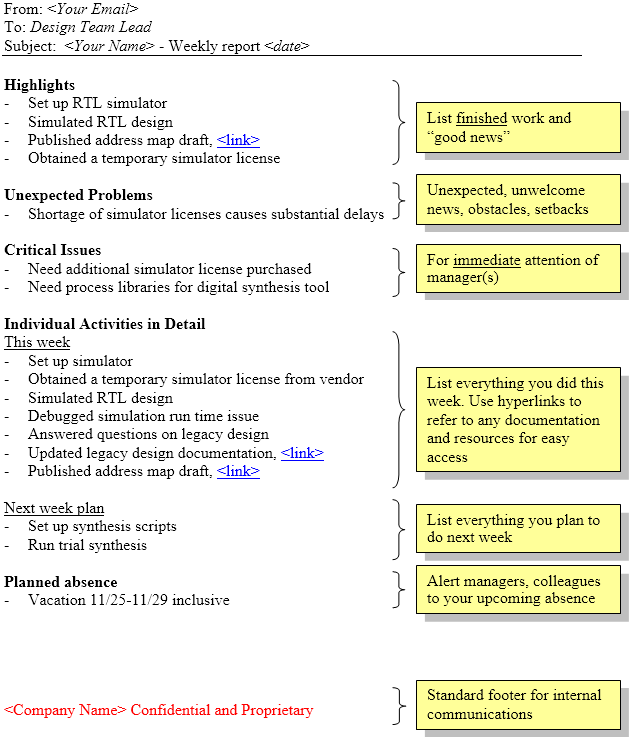Customizing Team Member Reports
The basic report serves as a template that can be customized to fit the particular organization and its needs. Here are some possible customizations.
- Task status
Reporting tasks assigned to the team member and the percent of their completion can be helpful for project management. Task status can be formatted as a table. The project manager can copy this information into his schedule tracking software such as MS Project. Alternatively, if the team member updates schedule directly, he can copy relevant portions of the updated schedule into the report. See the article about online schedule tracking for more details.
- Activities for each day
Sometimes upper management may want to know how time was spent every day. Reporting daily activities can be done in the form of a table or by copying the daily time card, when applicable.
- Other Accomplishments
Some accomplishments may not relate directly to the projects at hand and thus may fit well into the “Highlights” section. Such items can be reported in a separate section named “Other Accomplishments”.
Customizing Team Manager Report
- Project or task status
When appropriate – particularly when the team manager is also the technical lead (called in short team lead), the report may contain a snapshot of the project completion status and schedule. The completion is usually specified in percent. The schedule can be reported as a snapshot of the Gantt chart or a table of task names and associated percent of completion.
- “Work in Progress” section
Have a “Work in Progress” section if the upper manager is interested to know what the team was doing during the reporting period, how time was spent – instead of or in addition to what was done, accomplished. This section should list all items from individual reports that did not go into the “Highlights” section.
- Translation
If the team member does not speak English, his or her report could be written in the native language. The team manager should translate that – or have that translated – into English and place in the Individual Activity section. A summary translation – a shortened version – may be acceptable.
- Shortened report
Individual activities and plans section can be removed and replaced with links to individual contributor reports. Alternatively, individual reports can be attached to the weekly instead of using the links. However, this approach may lack the convenience of seeing at-a-glance how time was spent by each team member. Next week plans cannot be seen at-a-glance too.
Troubleshooting Weekly Reports
Late or Missing Reports
- Do send weekly reports on time, even if some individual reports are late. This demonstrates that you take deadlines seriously.
- If an individual report is missing, summarize what you know about the progress of the team member who’s report is late. Substitute your own summary for team member’s report and indicate clearly that you wrote the status for that team member.
If the team member’s report contains critical information which you don’t know, consider calling or texting the team member and getting the status in real time. - After publishing the weekly, send a quick email to team members who’s reports are missing asking to send their reports ASAP anyway. You still may need those reports, even if they are late. This is especially important if the team member is under-performing. Late or missing reports may document the performance problem and serve as the paper trail to justify corrective actions. Lastly, by requesting the report you are also sending a message that being late is not acceptable – discipline is important.
- Schedule time with weekly reminder for the team to prepare individual reports. This will help ensuring it will not be taken away by other meetings. For example, in Outlook create a 30-minute weekly meeting before the reporting deadline with a pop-up reminder.
- If the reporting person has a planned absence on the day of report, he/she is responsible for sending in a report before he/she leaves. Planned absence is not an excuse. Only unplanned absence is.
- If the reporting day falls on a holiday, send a friendly reminder on the last day before holidays begin asking to send individual reports before leaving home.
- Do not miss reports yourself. Always designate a second-in-command to write the weekly report for you when you cannot do it. Show by example that taking care of business is a priority and things must get done regardless of someone’s absence
Reporting Language Problems
What if the reporting language is English, but some team members cannot not write in English well? If the team member can write broken English that can be understood – ask to use English. If the team member cannot write in English at all – make an exception and allow reporting in the team member’s native language.
However, the individual report should be translated into English – however briefly. The person to translate preferably should be the team manager – if the team manager speaks that language. Other possibilities include, if applicable, the administrative assistant or translator. Consider using translation software if all else fails.
Conclusion
To conclude the series of posts on weekly reporting – I feel that weekly reports are a critical and powerful instrument in the manager’s toolkit. The importance of this instrument should not be overlooked. I hope you see by now exactly what it is good for, how to use it and in particular how to get the most of it.

